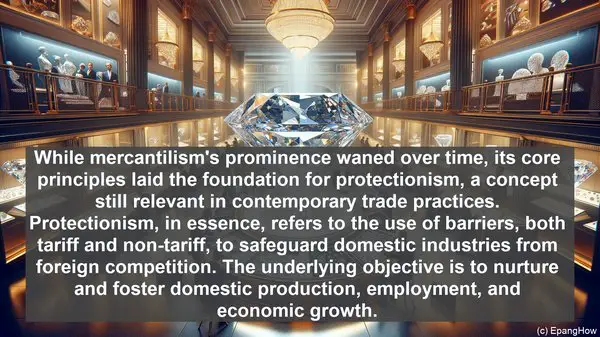Introduction: The Economic Landscape
Greetings, fellow enthusiasts of the intricate world of economics! As we navigate the vast expanse of trade and commerce, it becomes essential to comprehend the various ideologies and policies that shape this realm. Today, we embark on an enlightening journey to differentiate between two such concepts: mercantilism and protectionism.

Mercantilism: A Historical Perspective
To truly grasp the essence of mercantilism, we must rewind the clock to the 16th century. Originating in Europe, this economic doctrine revolved around the belief that a nation’s wealth and power were directly linked to its accumulation of precious metals, particularly gold and silver. Mercantilist policies aimed to achieve a favorable balance of trade, wherein exports exceeded imports, ensuring a constant inflow of precious metals.
Key Tenets of Mercantilism
Mercantilism was characterized by several key tenets. First, it emphasized the importance of colonies as sources of raw materials and markets for finished goods. Second, it advocated for protectionist measures, such as tariffs and quotas, to shield domestic industries from foreign competition. Additionally, mercantilism encouraged a strong central government, which would actively intervene in economic affairs to promote national interests.
Protectionism: A Modern-Day Approach
While mercantilism’s prominence waned over time, its core principles laid the foundation for protectionism, a concept still relevant in contemporary trade practices. Protectionism, in essence, refers to the use of barriers, both tariff and non-tariff, to safeguard domestic industries from foreign competition. The underlying objective is to nurture and foster domestic production, employment, and economic growth.
Forms of Protectionism
Protectionism can manifest in various forms. Tariffs, or taxes on imported goods, are a commonly employed measure. Quotas, which restrict the quantity of imports, are another tool. Non-tariff barriers, such as product standards and regulations, can also serve as protectionist measures. Additionally, subsidies, financial assistance provided to domestic industries, are often utilized to enhance competitiveness.
The Great Debate: Pros and Cons
The realm of economics is often marked by spirited debates, and the topic of mercantilism and protectionism is no exception. Advocates of protectionism argue that it safeguards domestic industries, prevents job losses, and fosters self-sufficiency. On the other hand, critics contend that it can lead to reduced consumer choices, inefficiencies, and trade tensions.
The Modern Landscape
In today’s globalized world, where supply chains span continents and trade agreements are the norm, the dynamics of international commerce have evolved. While protectionist measures still find application, there is also a growing emphasis on free trade, with countries seeking to leverage the benefits of globalization and interconnectivity.

